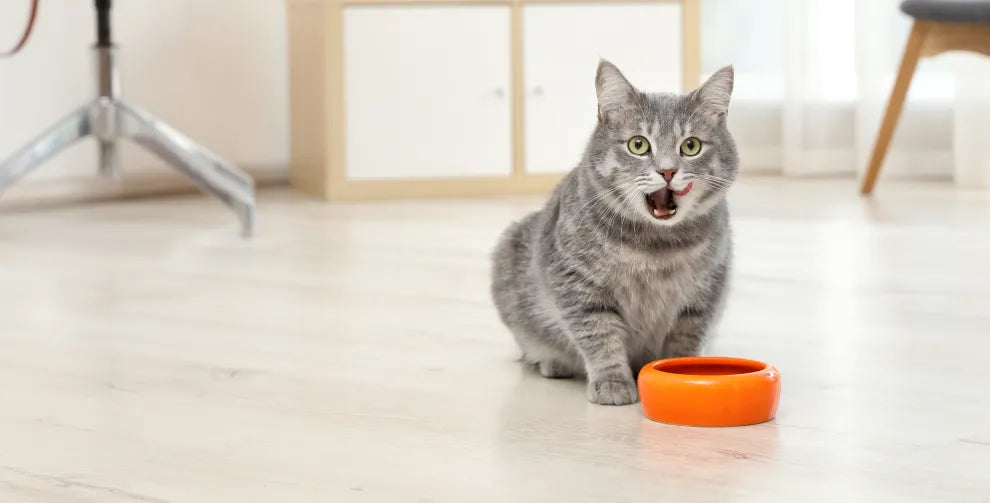How long does it take a cat to digest food?

Medically Reviewed by: Dr. Caley Scott, ND
Cats are mysterious creatures by nature, and owners might not know about their inner workings and optimal health. While cats are generally easy pets to care for, they can often encounter digestive issues that can impact their well-being or even cause chronic issues.
It goes beyond just serving them the right food and limiting table scraps — caring for your cat means knowing how their digestion works and taking the right steps to support it.
In this article, we’ll cover the basics of a cat’s digestive process, detailing how long it takes for food to go from A to Z. This will lay the groundwork for you to identify issues that may cause digestive difficulties for your pet, and present some ways to address them.
How does a cat’s digestive process work?
A cat’s digestive process is similar to that of humans and other mammals, but with minor differences that must be accounted for. Here, we’ll walk through each part of a cat’s digestion and estimate how long each part of the process should take.
Ingestion and esophagus
When you serve your cat dinner or toss them a snack, the digestion process has already begun with the release of saliva and the priming of the digestive system. Through scent and visual cues, cats know when it’s time to eat, and produce saliva that helps to chew and process food from the moment of first contact.
Cats tend to eat quickly, and usually don’t take large portions of food. This means that the typical ingestion process won’t take more than a few minutes. While cats may appear to be chewing vigorously, their teeth don’t do much to break down food before swallowing.
The digestive enzymes do most of the work in this phase, as food is then moved down the esophagus and into the stomach.
Stomach breakdown
As food makes its way to the stomach, it enters a highly acidic environment, with gastric juices like hydrochloric acid breaking down proteins and other macronutrients. Additionally, a cat’s stomach features a churning mechanism that keeps these materials moving and increases surface area contact with enzymes and acids.
Think of a washing machine that spins to distribute water and detergent evenly across clothes and fabrics to get a total clean. The same action occurs in this part of the digestive process in a cat, which must ensure the complete breakdown of solid food materials in this important phase.
Because cats benefit most from a high-protein diet, food in the stomach may take longer to digest than other mammals with a similar digestive structure. With that said, it usually takes between two to four hours for a cat’s stomach to turn solid food into a chyme, the semi-liquid substance that the intestines can process.
Small intestine stage
Once most of the solid food in the stomach is converted to chyme, the material moves into the small intestine, where the digestion and absorption process ramps up. Chyme still contains the majority of the moisture and nutrients from food, which the walls of the small intestine are able to absorb as it moves along these winding pathways.
The small intestine does much of the work here, but the process is aided significantly by the pancreas and liver. These organs contribute enzymes and bile to help separate and process fats, carbs, and proteins in preparation for absorption.
This is the longest phase of digestion yet, taking anywhere from 8 to 12 hours depending on the cat’s age, metabolism, and other health and environmental factors.
Large intestine and excretion
The large intestine, also called the colon, is responsible for the final stage of digestion in cats, and also sets the stage for effective extraction. In this phase, the remaining chyme goes from the small to the large intestine, where water and electrolytes are taken from this undigested material.
By this point, most of the valuable nutrient compounds have been stripped away from the chyme, and only a small amount of moisture remains. The large intestine compacts this material to be formed into feces and also uses a fermentation process to synthesize vitamins and convert fibers. All in all, this phase can take between 12 and 24 hours, depending on a cat’s health and diet.
This is where the gut microbiome comes into play, as a healthy balance of bacteria is key to a smooth and stable final stage of digestion. Cats with a strong gut microbiome will typically have an easier time extracting moisture, nutrients, and other valuable components during this process, allowing them to excrete efficiently and reserve energy for other important biological functions.
Why should cat owners know about digestion?
It can take up to a day and a half for a cat to fully process, digest, and eliminate food material — but why does this matter to cat owners? If you want to be the best cat parent possible, that means knowing the mechanics of cat digestion and using this info to better care for your pets.
Consider all the variables at play with cat nutrition, from weight management and health monitoring to allergy identification, gut health, and activity levels. Digestion and metabolism are the engines that keep a cat moving and living well, so being able to identify issues or irregularities can make all the difference in a cat’s life.
You don’t need to be a cat health expert to use this information effectively. However, understanding the basics and having a toolkit to make adjustments is a part of smart, caring pet ownership that we should all be committed to.
What are the most common cat digestion problems?
Now that we know the importance of digestion in the grand scheme of cat health and well-being, it’s time to look at some common gastrointestinal issues that cats face in their lifetime. Cat owners will likely encounter at least one of these problems at some point in their cat’s life, so be prepared, know what signs to look for, and you’ll be a step ahead at every turn.
Foreign objects and hairballs
Cats are smart, but even the sharpest felines can let their curiosity get the best of them. Cats may consume objects around the house that aren’t meant to be digested, from small toys and parts to bits of dirt or rocks.
Since owners can’t reasonably keep an eye on their cats 24/7, do your best to keep a clean and tidy environment and store any items that cats could consume accidentally. If you think your cat has eaten something they shouldn’t have, make your way to the vet ASAP.
Hairballs are harder to avoid but can lead to similar problems with digestion or even block airways. Look for signs like lethargy, discomfort, or excessive grooming that may lead to vomiting or more severe issues.
Food allergies and sensitivities
Cats may be prone to food allergies, which are often caused by a single ingredient or type of food. If you suspect your cat is sensitive to a food type or experiencing allergic reactions, try swapping out their food plan for something else while taking note of key ingredients.
On the other hand, avoid feeding cats table scraps or human snacks, even if they are considered “safe” for cats. This ensures that your cat maintains a healthy, consistent diet without any unusual food types that may disrupt their daily digestion.
Excretion issues
Constipation and diarrhea are common among cats, especially as they age. While you don’t need to examine the litter box every day, you can look for signs that cats may be having issues with excretion and other problems with the final stage of digestion.
You may need to introduce a new type of food to help cats overcome this challenge, or incorporate probiotic supplements that will support their gut microbiome. Our Broad Spectrum Probiotic CBD Pet Chews feature a rich variety of probiotic compounds, plus prebiotic fiber sources and a pet-friendly serving of CBD for extra soothing comfort.*
If you notice your cat is having trouble with digestion, but you can’t seem to pinpoint the source of the problem, these pet chews can address many small and common issues in one go. Plus, cats love the flavor of these easy-to-eat snacks, and the calming effects of CBD can help them stay comfortable when navigating digestive troubles.*
Parasites, viruses, and bacteria
Cats are generally clean animals, and their immune systems are capable of fending off foreign bodies like viruses and parasites. If your cat tends to stay indoors, they are unlikely to encounter microbes that cause these types of problems.
On the other hand, an indoor lifestyle can weaken the immune system over time, leading them to be more vulnerable in the long term and in older age.
With these factors in mind, keep an eye out for irregular behavior that may indicate the presence of bacteria or parasites. Tapeworms, for example, will cause your cat to eat more while still losing weight, while bacteria may cause problems like diarrhea or erratic behavior.
These problems are fixable, thankfully, so don’t hesitate to contact your trusted veterinarian to get them the right diagnosis and path to treatment.
Pancreas problems
We’ve touched on the importance of the pancreas in the digestive process, as this organ emits key compounds that help break down food. Unfortunately, cats have a sensitive pancreas that can be subject to dysfunction, sometimes resulting in a condition called pancreatitis.
This condition can be difficult to pinpoint or solve, so it’s typically not a DIY fix that you can address with dietary or lifestyle changes. Look for signs of abdominal pain or discomfort in your cat, and bring them to a vet so that you can get the proper diagnosis and care.
The bottom line
Knowing the details of cat digestion might not be your top priority as a cat owner, but it’s important to their health nonetheless. If you’ve checked all the other boxes of cat care, consider this the next level of support you can offer your cat, whether they’re young or old.
With Sunmed’s CBD for pets and a diligent approach to monitoring your cat’s health, you can get ahead of issues before they cause lasting damage or discomfort. Take the same approach to your cat's health as your own, and you’ll both enjoy your years together to the fullest.
Sources:
Surgical Anatomy of the Gastrointestinal Tract in Cats | NIH











